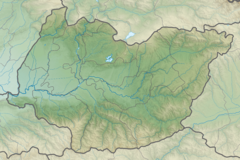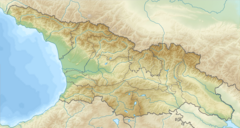Gelati Monastery facts for kids
Quick facts for kids Gelati Monastery |
|
|---|---|
|
გელათის მონასტერი
|
|

The monastic complex of Gelati
|
|
| Religion | |
| Affiliation | Georgian Orthodox Church |
| Location | |
| Location | Kutaisi, Imereti, Georgia |
| Architecture | |
| Architectural type | Monastery |
| Architectural style | Georgian |
| Founder | David IV of Georgia ("David the Builder") |
| Completed | Church of the Virgin, 1106; Churches of St. George and St. Nicholas, 13th century |
| Official name: Gelati Monastery | |
| Type | Cultural |
| Criteria | iv |
| Designated | 1994 (18th session) |
| Reference no. | 710 |
| Region | Europe and North America |
|
Invalid designation
|
|
| Official name: Gelati Monastery | |
| November 7, 2006 | |
| 875 | |
| Item Number in Cultural Heritage Portal | 8550 |
| October 3, 2007 | |
The Gelati Monastery (Georgian: გელათის მონასტერი) is a very old church complex. It is located near Kutaisi in western Georgia. King David IV of Georgia started building it in 1106. He wanted it to be a special place for both religion and learning.
This monastery is a great example of the Georgian Golden Age. This was a time when Georgia was very strong and creative. The buildings and paintings at Gelati use a lot of gold colors. This shows how important the Orthodox Christian faith was in Georgia. Some of the wall paintings inside are from the 12th century. In 1994, UNESCO named Gelati a World Heritage Site. This means it is a very important place for everyone in the world to protect.
Contents
What is Gelati Monastery?
The monastery sits on a hill a few kilometers northeast of Kutaisi. It also looks over the Tskaltsitela Gorge. The buildings are made of strong stone. They have many beautiful archways.
The main church is shaped like a cross. This shape is a symbol of Christianity. The monastery was built so it could be seen from far away. Its stone walls were made to reflect sunlight. You can see archways all over the monastery, even in the bell tower.
A Look at Gelati's Past
Building the Gelati Monastery started in 1106. King David IV of Georgia led the project. At that time, Kutaisi was the capital city of Georgia. The monastery was built during the time of the Byzantine Empire. Christianity was the main religion then.
The main church, called the Church of the Virgin, was finished in 1130. This was during the rule of King David IV's son, Demetrius I of Georgia. It was dedicated to the Virgin Mary. King David IV is buried at the monastery. Near his burial spot, you can find the Ancient Gates of Ganja. King Demetrius I brought these gates here in 1138. The smaller chapels in the monastery were built later, in the 13th century.
Gelati as a Learning Center
Gelati Monastery was not just for religious purposes. It was also a famous place for science and education. King David IV invited many Georgian scientists and thinkers to work there. Many of them had studied in other Orthodox monasteries. For example, Ioane Petritsi translated important philosophy books. Arsen Ikaltoeli wrote a book of teachings called Dogmatikon.
The Gelati Academy also had people who copied important books by hand. People at that time even called Gelati "a new Hellas" and "a second Athos". This shows how important it was for learning.
Amazing Art at Gelati
The monastery has many beautiful artworks.
Triptychs
Triptychs were popular during the Byzantine Empire. They were very important in Georgian culture. A triptych is a picture or carving with three panels. These artworks helped people in the church understand their faith.
One very special artwork was the Khakhuli triptych. This was a valuable icon kept at Gelati from the 12th century. Sadly, it was stolen in 1859. It was returned in 1923, but it was not in its original perfect condition.
Mosaics
Inside the monastery, you can see amazing mosaics. These are pictures made from small pieces of colored stone or glass. They are in the classic Byzantine style. They show different parts of Christian belief.
The largest mosaic is from the 12th century. It shows the Virgin Mary holding baby Jesus. This mosaic is in the main church's apse (the curved part behind the altar). It is a very important piece of art for Georgia. Above the altar, there is also a statue of the Virgin Mary looking down at baby Jesus.
Protecting Gelati Monastery
The monastery is still active today. Its churches are still used for religious services. UNESCO helps to restore and protect the site. All the original buildings are still standing and being used.
Some of the mosaics and murals were damaged in the past. But Georgian experts stopped this damage by replacing the roof of the academy building. In 2006, the monastery was added to Georgia's National Register of Monuments. This helps make sure it is protected and restored for the future.
Important Burials
Many important people are buried at Gelati Monastery. These include several kings and queens of Georgia:
- Demetrius I of Georgia
- David IV of Georgia
- David V of Georgia
- Solomon I of Imereti
- Solomon II of Imereti
- George III of Georgia
- Vakhtang II of Georgia
- Bagrat V of Georgia
- Bagrat VI of Georgia
- David IX of Georgia
- George V of Georgia
- Alexander II of Imereti
- George of Chqondidi
- Tamar of Georgia
Gallery
-
Archangel Michael, mosaic fresco
-
The Ascension, mural (16th century)
-
David IV of Georgia, mural
-
Icon of St. George in front of the iconostasis
See Also
- Culture of Georgia
- Georgian Orthodox and Apostolic Church
- Motsameta monastery
- World Heritage Sites in Danger





























